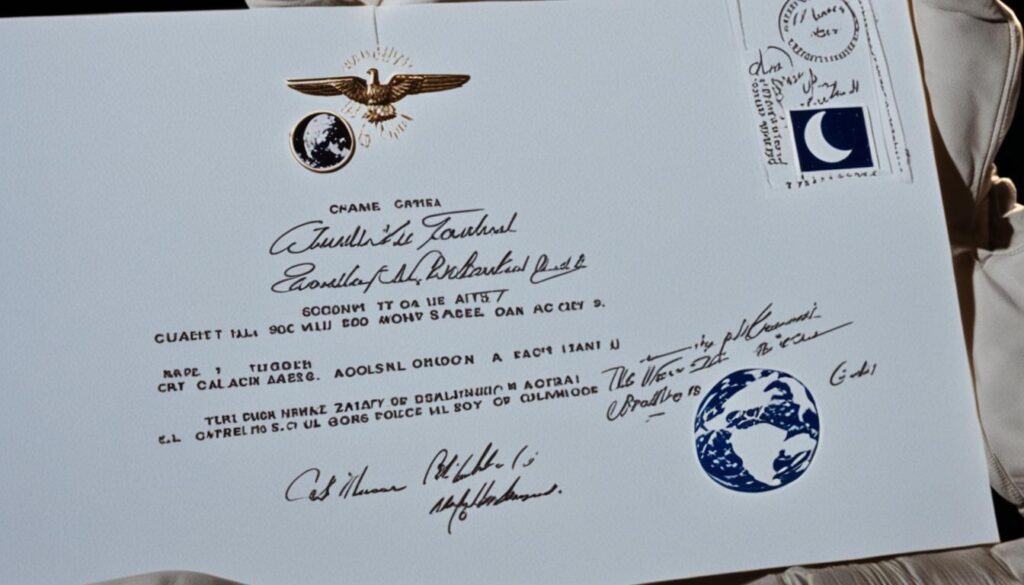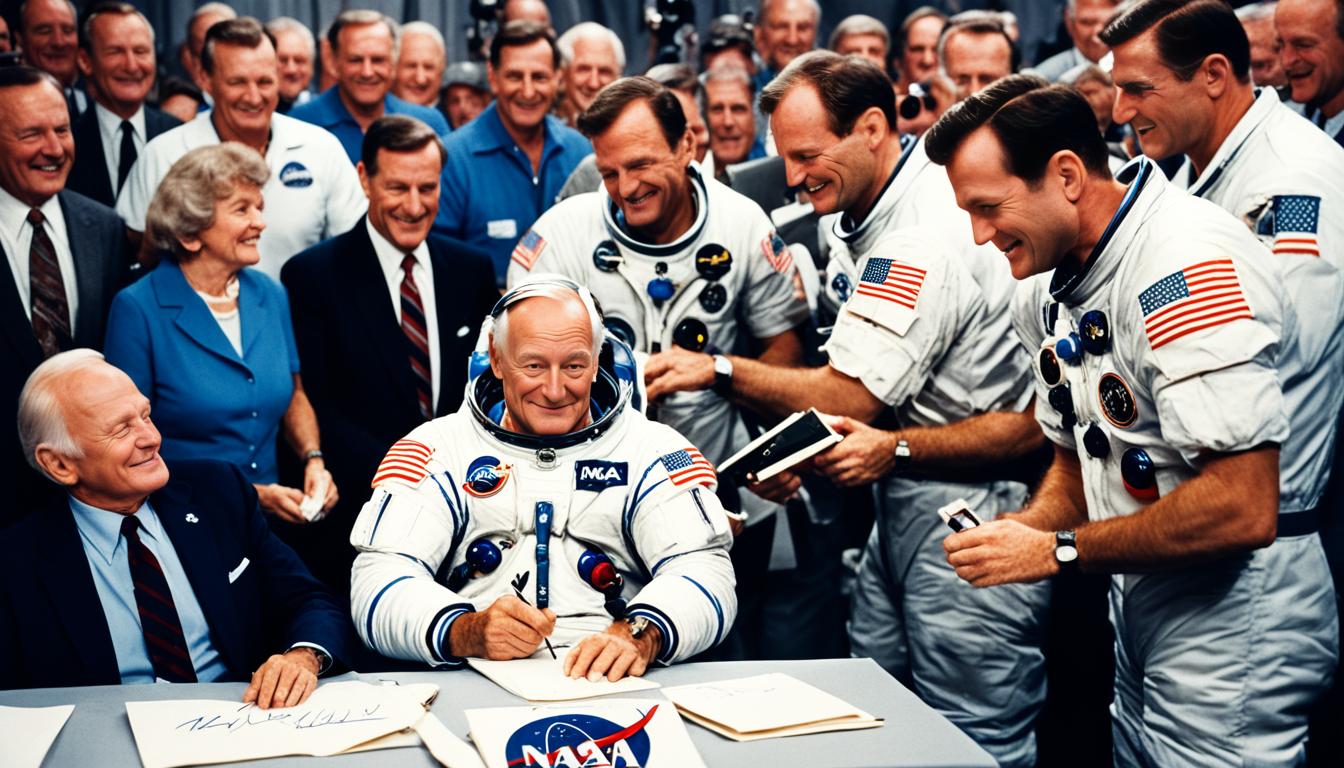In the days leading up to the historic Apollo 11 mission, astronauts Neil Armstrong, Buzz Aldrin, and Michael Collins faced an extraordinary challenge beyond their rigorous training and the inherent dangers of spaceflight. Due to the unprecedented risk associated with their lunar mission, obtaining affordable life insurance proved nearly impossible for these brave explorers. Undeterred, the Apollo 11 astronauts devised a creative solution to ensure their families’ financial security: signing hundreds of autographs.
As the launch date approached, the astronauts spent their limited free moments during the intense training and quarantine period signing their names on various items, particularly envelopes postmarked with key dates related to the mission. These autographs served as a form of makeshift life insurance, with the assumption that their value would skyrocket if the astronauts perished during the mission, providing financial support for their loved ones. Remarkably, even in the face of such enormous pressure, Armstrong, Aldrin, and Collins found a way to protect their families while focusing on the task at hand: successfully navigating to the moon and back. The ingenuity and foresight demonstrated by the Apollo 11 in this unique life insurance arrangement underscore the depths of their commitment and bravery.
Key Takeaways
- Apollo 11 astronauts faced difficulty obtaining affordable life insurance due to the mission’s high risk.
- As a creative solution, the astronauts signed numerous autographs on envelopes and other items.
- The autographs, particularly those postmarked with important mission dates, were considered valuable in the event of the astronauts’ deaths.
- This unconventional life insurance approach allowed the astronauts to protect their families financially while focusing on the mission.
- The astronauts’ resourcefulness highlights their dedication and courage in the face of unprecedented challenges.
The Unprecedented Risk of the Apollo 11 Mission
The Apollo 11 mission was a groundbreaking endeavor that pushed the boundaries of human exploration. As the first manned mission to the Moon, it represented an extraordinary leap forward in space travel. However, the risks associated with this unprecedented journey were immense, and the astronauts faced numerous challenges that threatened their lives and the success of the mission.
One of the most significant concerns for the Apollo 11 crew was the lack of adequate life insurance policies. Insurance companies were hesitant to provide coverage for the astronauts due to the inherent dangers of space exploration. The moon landing was an uncharted territory, and the potential for catastrophic failure was high. Insurers deemed the risks too great to offer affordable policies, leaving the astronauts and their families in a precarious financial position.
The astronauts understood the gravity of the situation and the potential consequences for their loved ones. If the mission had gone wrong and they had not returned safely, their families would have been left without financial security. The thought of leaving their wives and children in a difficult situation weighed heavily on the minds of Neil Armstrong, Buzz Aldrin, and Michael Collins as they prepared for the historic moon landing.
Despite the overwhelming risks and the lack of traditional life insurance policies, the Apollo 11 astronauts remained committed to their mission. They recognized the importance of their journey and the potential impact it could have on the future of space exploration. The crew’s bravery and determination in the face of uncertainty were a testament to their dedication and the unwavering support of their families.
As the world watched with bated breath, the Apollo 11 mission launched on July 16, 1969. The astronauts embarked on their perilous journey, fully aware of the risks they faced. The success of the mission was far from guaranteed, and the possibility of failure loomed large. Yet, the crew remained focused on their goal, determined to overcome the challenges and make history by setting foot on the lunar surface.
Apollo 11 Autograph Insurance: A Creative Solution
Faced with the unprecedented risk of their mission and the inability to secure affordable life insurance, the Apollo 11 crew devised an ingenious plan to protect their families financially. Neil Armstrong, Buzz Aldrin, and Michael Collins decided to sign hundreds of autographs on envelopes, which would serve as a form of makeshift autograph insurance.
The astronauts were well aware that their signatures would become highly valuable space memorabilia, especially if the mission were to end in tragedy. By signing numerous envelopes before the launch, they hoped to provide their loved ones with a tangible asset that could be sold if the need arose.

To ensure the authenticity and value of the signed envelopes, the Apollo 11 crew entrusted them to a close friend. This friend was tasked with having the envelopes postmarked at key points during the mission, such as the launch date, the day of the moon landing, and the date of their safe return to Earth. By doing so, the envelopes would serve as a historical record of the mission’s progress and increase in value as collectible items.
Once the mission was complete and the astronauts had returned safely, the postmarked envelopes were distributed among the families of Armstrong, Aldrin, and Collins. These unique items served as a form of autograph insurance, providing the families with a valuable asset that could be sold if financial hardship struck in the aftermath of the mission.
The Apollo 11 crew’s resourceful plan demonstrates their ingenuity and dedication to ensuring their families’ financial security in the face of the mission’s uncertainties. Today, these signed envelopes are highly sought-after space memorabilia, serving as a testament to the bravery and quick thinking of these pioneering astronauts.
The Successful Return and Legacy of Apollo 11
On July 20, 1969, the Apollo 11 mission achieved its ultimate goal as Neil Armstrong became the first person to set foot on the moon, forever etching his name in history. The momentous occasion marked the culmination of years of tireless work and innovation, as well as the bravery and determination of the Apollo 11 crew. After spending over 21 hours on the lunar surface, Armstrong and Buzz Aldrin rejoined Michael Collins in the command module, and the trio began their journey back to Earth.
Four days after the historic moon landing, the Apollo 11 astronauts splashed down safely in the Pacific Ocean, rendering their makeshift autograph life insurance unnecessary. The signed envelopes, which had served as a poignant reminder of the mission’s inherent dangers, became cherished family mementos and highly coveted collectors’ items. Today, these autographs stand as a testament to the courage and ingenuity of Armstrong, Aldrin, and Collins, who were willing to risk everything in the name of space exploration and scientific advancement.
The legacy of Apollo 11 extends far beyond the astronauts’ safe return and the moon landing itself. The mission ignited a passion for space exploration that continues to burn brightly more than half a century later. It inspired generations of scientists, engineers, and dreamers to pursue careers in STEM fields and push the boundaries of what is possible. Organizations like the Astronaut Scholarship Foundation have harnessed this enduring enthusiasm, using proceeds from the sale of space memorabilia to fund scholarships for students committed to carrying on the legacy of the Apollo program and its intrepid astronauts.
As we look to the future of space exploration, with ambitious plans for missions to Mars and beyond, the Apollo 11 story serves as a powerful reminder of the incredible feats that can be achieved through human perseverance, teamwork, and the relentless pursuit of knowledge. The autographs that once served as a contingency plan now stand as a symbol of the unwavering spirit that propelled Armstrong, Aldrin, and Collins to the moon and back, cementing their place in history and inspiring us to reach for the stars.

Leave a Reply